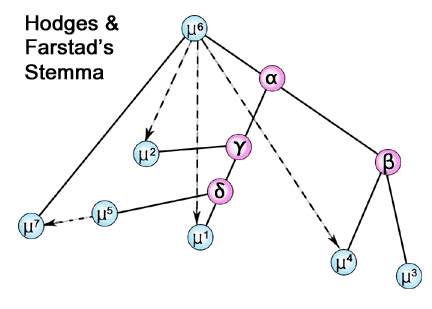A Technical Review
by
Nazaroo
Synopsis
The publication of the Hodges and Farstad Majority Text is a monumentous achievement in scholarship, and heralds an important new era the study of the Greek New Testament underlying almost all English translations. While other critical Greek texts have languished in the textual theories and crude methods of the 19th century, this text is based on the more recent and most exhaustive collations of manuscripts done, to the date of its publication (1985). The editors have used the outstanding work of von Soden as a base, and corrected, supplimented, and modernized that work for English readers and researchers.
But perhaps more importantly in the long run, the editors have reopened the question of the Byzantine (Majority) text for consideration in the reconstruction of the original New Testament. The theories of an earlier generation of scholars such as Griesbach, Tregelles, and Westcott & Hort, have long held sway at least among liberal scholars in this specialized field. Yet now, as that work has been critically assessed under the light of new discoveries and modern methodologies, the pendulum has been slowly but surely approaching a nexus for reversal of previous trends and approaches.
Because this is such a specialized and technical field, the only way to adequately review the work is to examine a small but significant portion and treat it rather thoroughly, in order to give a idea of the depth and quality throughout. For this purpose we have chosen the handling of the Pericope de Adultera (John 7:53-8:11) as a 'test-case' for assessment. Although we must of necessity exerpt rather large portions of the introduction relevant to those twelve verses, it must be remembered that this in fact is a small sample of the massive work which this beautiful book of over 800 pages contains. It hardly represents the vastness and breadth of the actual task the editors have shouldered in embracing the problem of the entire New Testament text and its transmission history of nearly 2000 years.
Preface
...
In the passage about the adulterous woman, there is a single apparatus using numbered footnotes. Here the varied strands are divided into M1 through M7 (the same division von Soden uses, except that we substitute M for his lower case mu). Though we heavily depend on his detailed work here, our interpretation of the evidence is quite different from his. (preface, vii)...
The editors waste no time acknowledging their debt to the previous work upon which their own is based, and quickly delve into the details of the terrain and the text.
Introduction
A MAJORITY TEXT METHOD (pg xii)
...Final decisions about readings ought to be made on the basis of a reconstrucion of their history in the manuscript tradition. This means that for each New Testament book a genealogy of the manuscripts ought to be constructed. The data available for this in the standard sources is presently inadequate, except for the Apocalypse. In this edition, therefore, a provisional stemma (family tree) of manuscripts is offered for that book only. Textual decisions in Revelation are made on the basis of this genealogical reconstruction. Also, a provisional stemma is offered for John 7:53-8:11; and here, too, decisions about the text are based upon stemmatic factors.
It is true, of course, that most modern textual critics have despaired of the possibility of using the genealogical method. Nevertheless, this method remains the only logical one. If Westcott and Hort employed it poorly, it is not for that reason to be abandoned. In fact the major impediment to this method in modern criticism has been the failure to recognize the claims of the Majority Text. Any text-form with eexceedingly large numbers of extant representatives is very likely to be the result of a long transmissional chain. All genealogical reconstruction should take this factor into account.
... [The] impossibility [of genealogical work] however, will rest on this preference [for a small minority of texts,] and not on the intrinsic deficiencies of the method itself. The present edition is in no way fettered by a predilection for a small handful of manuscripts, whether very ancient or somewhat later. It seeks to track the original text in the vast body of the surviving documents. Where possible, this has been done stemmatically.
Here we are given a good look into the thinking, philosophical approach and methodology of the editors in the pursuance of their task. Interestingly, even in the case of the pericope de adultera, the authors are conservative, and careful to note the provisional nature of the stemmatic reconstruction done.
Most importantly however, the authors underline that they are not promoting any purely statistical reconstructions, or crude counting of manuscripts. They clearly consider the genealogical method and its results superior to a simple counting of witnesses, and attempt to apply it wherever possible. Finally, they state the need for reconstruction to be done within the constraints of a plausible history of the text and its transmission. Even when forced to rely upon 'consensus' methods, they insist upon operating with all the historical-critical tools available.
From this its clear that Hodges and Farstad are not 'Majority of MSS' advocates at all per se, but rather prefer genealogical methods, and rate them vastly superior to 'manuscript counts' when they are feasible.
Introduction
THE APPARATUS FOR JOHN 7:53-8:11
The materials furnished by von Soden for the famous story of the woman caught in adultery are much more adequate than those he provides for the rest of the New Testament. Here, in fact, von Soden completely collated all available copies of this pericope, more than nine hundred altogether. Though the precise data of these collations must be painstakingly gathered from his discussions, (and not from his apparatus alone), at least it is accessible. From it the editors of the present text have constructed a provisional stemma. This represents their understanding of the transmissional history of this narrative.
It is clear that the textual troubles which overtook the pericope began early. It is omitted by the most ancient witnesses for the Egyptian tradition, namely, P66,P75,Aleph, and B. It was also evidently absent from C and even from A, which in the gospels often sides with the Majority Text. But the joint testimony of these manuscripts, except perhaps for A, simply may point to a very ancient copy from which the passage was missing.
There is no compelling reason to doubt that the story is originally Johannine, despite the prevailing contrary opinion. Among the marks of Johannine style which it exhibits, none is clearer than the phrase in 8:6: touto de elegon peirazonteV auton. This is a pure and simple Johannism, which is evident by comparison with 6:6, 7:39, 11:51, 12:6, 33; and 21:19. Likewise the use of the vocative gunai (8:10) by Jesus to address a woman is a Johannine characteristic (cf. 2:4, 4:21, 19:26, cf. also 20:13, 15). The phrase mhteki amartane (8:11) occurs nowhere else in the New Testament, except John 5:14, and the historic present of agousi (8:3) is consonant with John's frequent use of this idiom.
Nor is the narrative improperly suited to the place where it is found in the overwhelming majority of the nine hundred copies which contain it. On the contrary, a setting at the Feast of Tabernacles (cf. 7:2,14) is ideal for the story. It was on just such an occasion, when Jerusalem was crowded with pilgrims, that strangers might be thrown together with the resulting sin around which the story centers. An interview with a woman in a court of the temple would likely have been in the Court of the Women. And that is evidently where Jesus was, as the reference to the "treasury" in 8:20 indicates. Moreover, the way in which the woman's accusers are driven to cover by the moral exposure which Jesus brings upon them furnishes a suggestive introduction to the initial Johannine reference to the Lord as the Light of the World (8:12). The setting of the incident at daybreak is likewise suitable (cf. 8:2) since the rising sun furnishes the natural backdrop for the same title. It is in fact to the sun (not the temple candelabra, as Hort thought) that the title Light of the World refers (cf. 9:4, 5; 11:9). Finally, as the Qumran finds have shown (cf. 1QS iii 6-7), the thought of forgiveness of sin experienced here by the woman is properly linked to the phrase "light of life" (8:12).
In view of the features of Johannine style that have been noted and the narrative's almost unique suitability to this context, the idea that the passage is not authentically Johannine must finally be dismissed. If it is not an original part of the Fourth Gospel, its writer would have to be viewed as a skilled Johannine imitator, and its placement in this context as the shrewdest piece of interpolation in literary history! Accordingly, the consideration of the narrative's text that follows assumes its Johannine authenticity.
Von Soden distinguished seven subgroups among the Greek manuscripts containing the pericope. These he designated with the siglum m (for moicaliV) and by a superscribed numeral. In the apparatus of the text presented herein von Soden's m has been changed to M, but his supersribed numbers have been retained. Thus our M1 = his m1, M2 = his m2,and so on. (This M1 is not to be confused with the M1 cited elsewhere in the gospels.) In von Soden's own stemmatic reconstruction of the textual history of the pericope (cf. Die Schriften, I, Part 1:524), M1 stands nearest the archetype, while M7 is the farthest removed. But von Soden's preference for M1 is unjustifiably influenced by his high regard for d5 (or D) and its close allies in this group. As usual, despite its age (5th century), D is an idiosyncratic text, and M1 as a whole is not very useful in reconstructing the original form of the story.
While a brief introduction is not the medium for fully explaining how a stemma can be constructed, the general contours of the method can be stated. A valid stemma must have the power to explain the descent of the readings in a natural way. Each hypothesized intermediate archetype must show itself to be the starting point of more than one reading which appears below it on the stemma, but not above. Where there is mixture, as there always is, the stemma should be able to disclose the probable source of most of it. Moreover, the readings found high on the stemma should quite often easily be seen as the natural progenitors of readings lower down which developed from them. In particular there ought to be some readings treated as original which are noticably superior to their rivals. When a stemmatic tree can pass all these tests at once, it has a high probability of being correct.
Below is given the projected family tree for the seven M groups containing the pericope. Some discussion of its justification will follow. A solid line indicates direct descent, while a broken line signifies mixture. The direction from which the mixture came is shown by the arrow. Greek letters designate the intermediate, but lost, connecting archetypes which the genealogy must necessarily presuppose. The stemma then is as follows:
Stemma of John 7:53-8:11From this diagram it can be seen that M6 is viewed as the original form of the pericope from which all other groups are descended. M6 is a substantial group which includes approximately 250 manuscripts. Very many of these are associated with Johannine texts which von Soden identifies with Kx. But M6 had its own stemmatic development, as its nearly even division on certain readings attests. Future investigators could profitably pursue the stemmatic analysis of M6 itself.
Another large and influential group is found in M5, comprising some 280 manuscripts. The large number of its representatives suggests that its origins are early. But the text it exhibits, over against M6, show marks of revision. M7 is a grouping of approximately 260 texts, many of which are to be associated with von Soden's Kr family. It has only one distinctive reading of its own (at 8:7) and is otherwise a composite of M6 and M5. An examination of its variants suggests that M5 is the source from which corrections were made on a base that was fundamentally M6.
The remaining groups are much smaller and their fundamental texts a bit harder to determine. The largest group among these is M2 which comprises only about forty manuscripts. All of these, along with M5, show signs of derivation from a common archetype, which on the diagram is designated a.
The plausibility of the proposed stemma can be shown by a consideration of some of the variant readings, which, although not exhaustively discussed herein, will be sufficient to illustrate the general method by which stemmatic problems were resolved.
Next the authors present a short summary evidence for authenticity, accompanied by a brief description of the various groups of manuscripts. In this process, a small amount of evidence is presented meant to re-enforce their own reconstruction. The groups are characterized and some of their general history are posited, based upon the view behind their stemmatic reconstruction.
At this time however, they decline to present either a compelling or complete case for their stemma, or even a clear description of the process of investigation (their methodology) by which the conclusions were actually reached. This must await the next section, after some curious cautionary remarks.
Discussion of Variants
These are the variants to be considered:
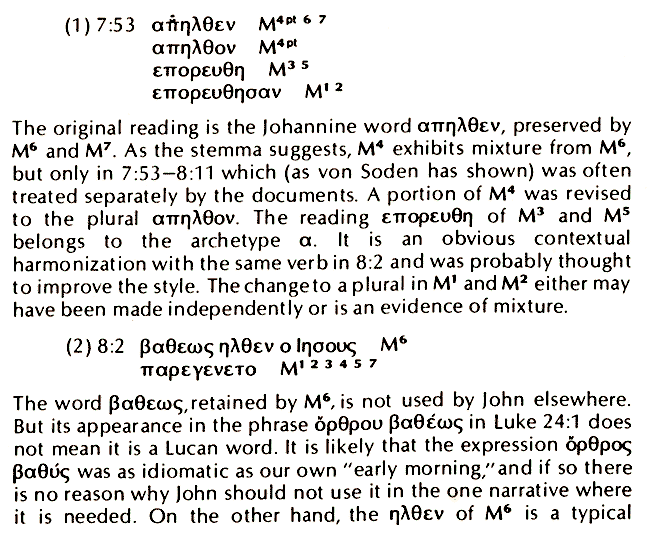
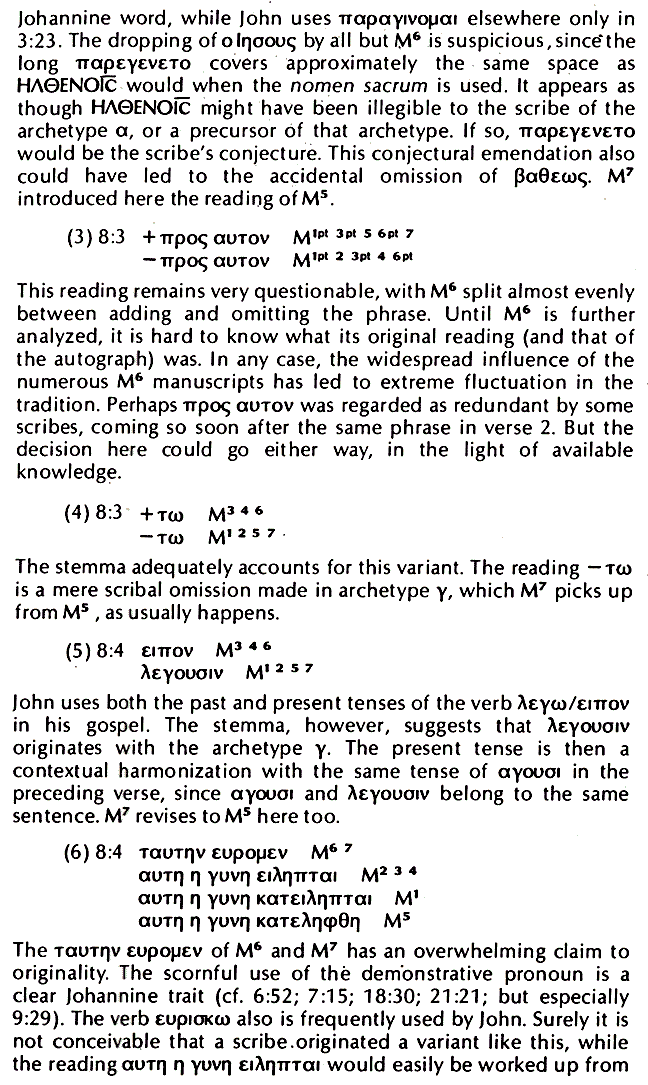
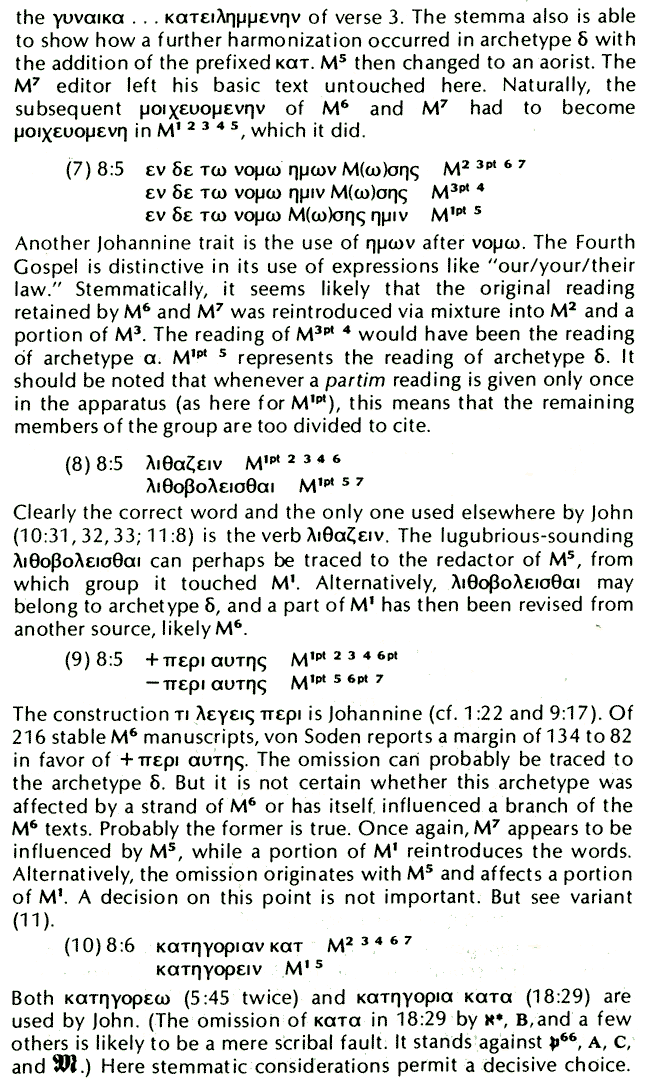
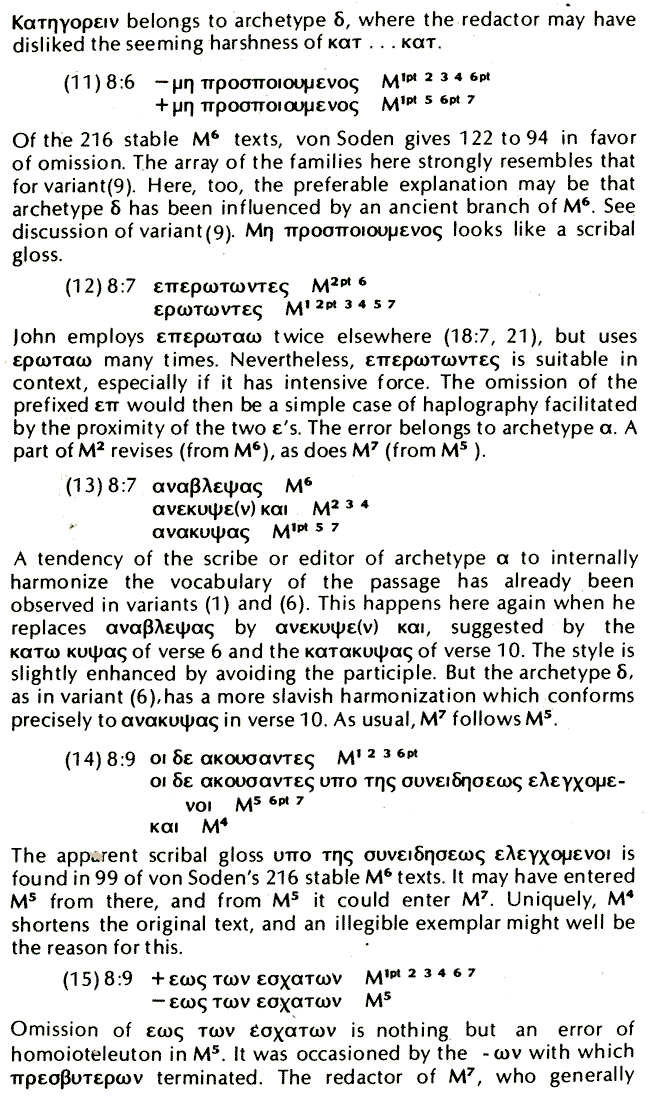
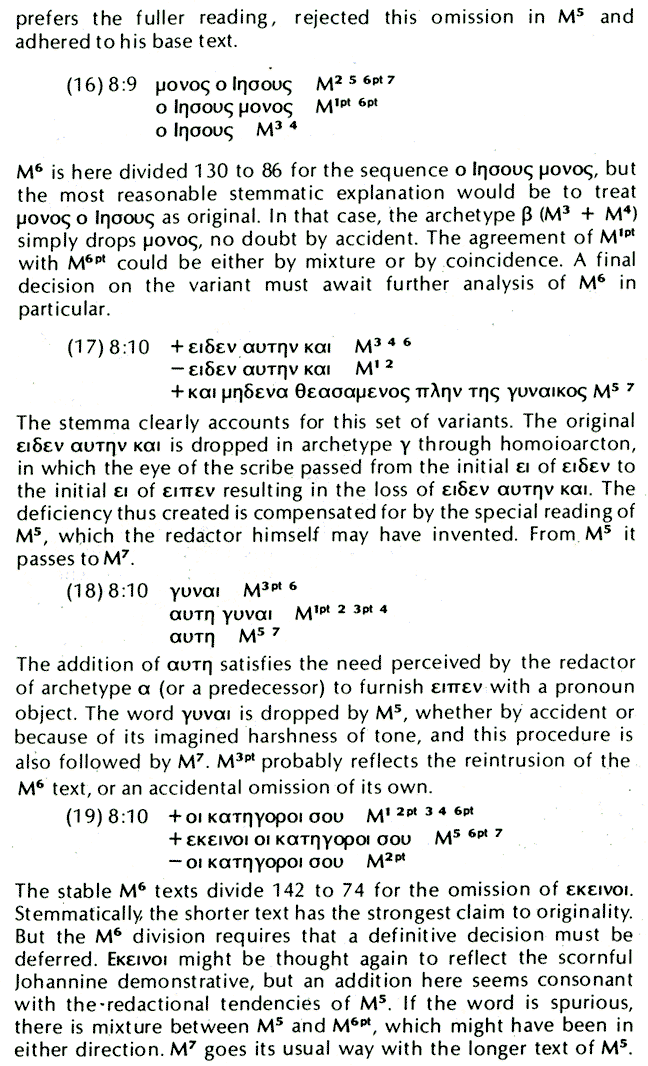
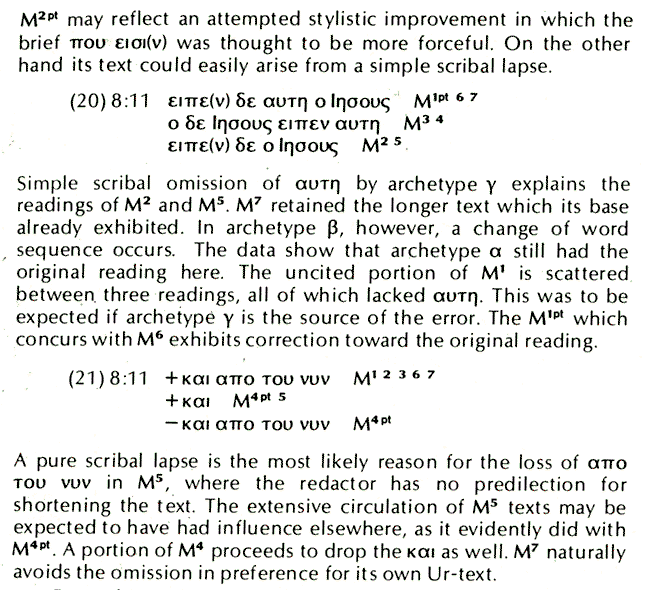
From the twenty-one readings considered, it should appear that the proposed stemma adequately accounts for the data of the manuscripts. The application of internal and transcriptional criteria to the variants themselves is safeguarded from undue subjectivity because it must be carried on within the constraints of a stemmatic outline of the textual history. How difficult it is to discover a viable stemmatic scheme within which the intrinsic qualities of the readings cohere naturally, only those who have attempted the process will know! But though the procedure is difficult, it is far from impossible. The resulting text of John 7:53-8:11, which is printed in this edition, contains a more evident Johannine stylistic cast than either the form presented in the Textus Receptus or that offered by the United Bible Societies and Nestle-Aland texts. This result speaks for itself."
(Introduction, pgs xxvi-xxxi)...The editors encourage all serious students of the text of the New Testament to analyze the data offered in the apparatus, which also may be supplimented by consulting von Soden (Die schriften, I, Part 1:486-524; Part 2:717-765). Only if the stemmatic reconstruction is searchingly evaluated can its provisional nature be advanced to the level of practical certainty. This calls for the cooperation of many minds.
(Introduction, pg xxxii)
And so a detailed discussion of 21 (out of about 34) of the major variants follows the general discussion. This is probably the first really in-depth discussion made this accessible to the layman. But the authors again caution us at the beginning and the end, that its intent is only illustrative, and the result remains provisional.
The discussion takes less the form of a 'case' for the stemma, as it does a kind of instructional talk. There is a tantalizing hint that a more complete explanation of their methods and evidence might be forthcoming, but that must remain an indefinite promise. We are left stimulated, but wondering how strong the case for this particular stemmatic reconstruction really is. This is the more pressing, since the authors have almost fully committed themselves to the M6 text, giving the largest and best attested group, M5 a backseat.
Still we are grateful for the immense amount of hard work and scholarship that has gone into this remarkable opus. The generous and frank discussions of the textual critical issues are refreshing and welcome. The academic professionalism and balance in presentation is warm and friendly. And above all, the authors have placed in our hands a powerful and useful tool in the research of the New Testament text.
Sample Pages of
Text and Apparatus:
John 7:53-8:11
Introduction (pg xxxi-xxxii)
Unlike the basic apparatus for most of the New Testament, the apparatus for John 7:53-8:11 is not divided into two parts. The obvious reason for this is that most of the variants considered would have qualified for first apparatus treatment anyway. Only in three places does the TR (Textus Receptus) or Cr (critical) text stand against
or M. The siglum
requires the concurrence of M5, 6, 7 groups which together include approximately eight hundred of the more than nine hundred manuscripts containing this pericope. Of course the use of this siglum does not imply that all eight hundred agree with the text, but the bulk of them do so. If M5 secedes from this concensus, but does not carry any other family with it, the siglum becomes M. All combinations of witnesses other than those just mentioned are treated as equivalent to an Mpt reading and are included in the apparatus. But instead of the generalized Mpt designation used elsewhere, the individual family groups are specifically mentioned. If no entry is found in the apparatus at any point, the reader may conclude that the printed text has the value of either
or M.
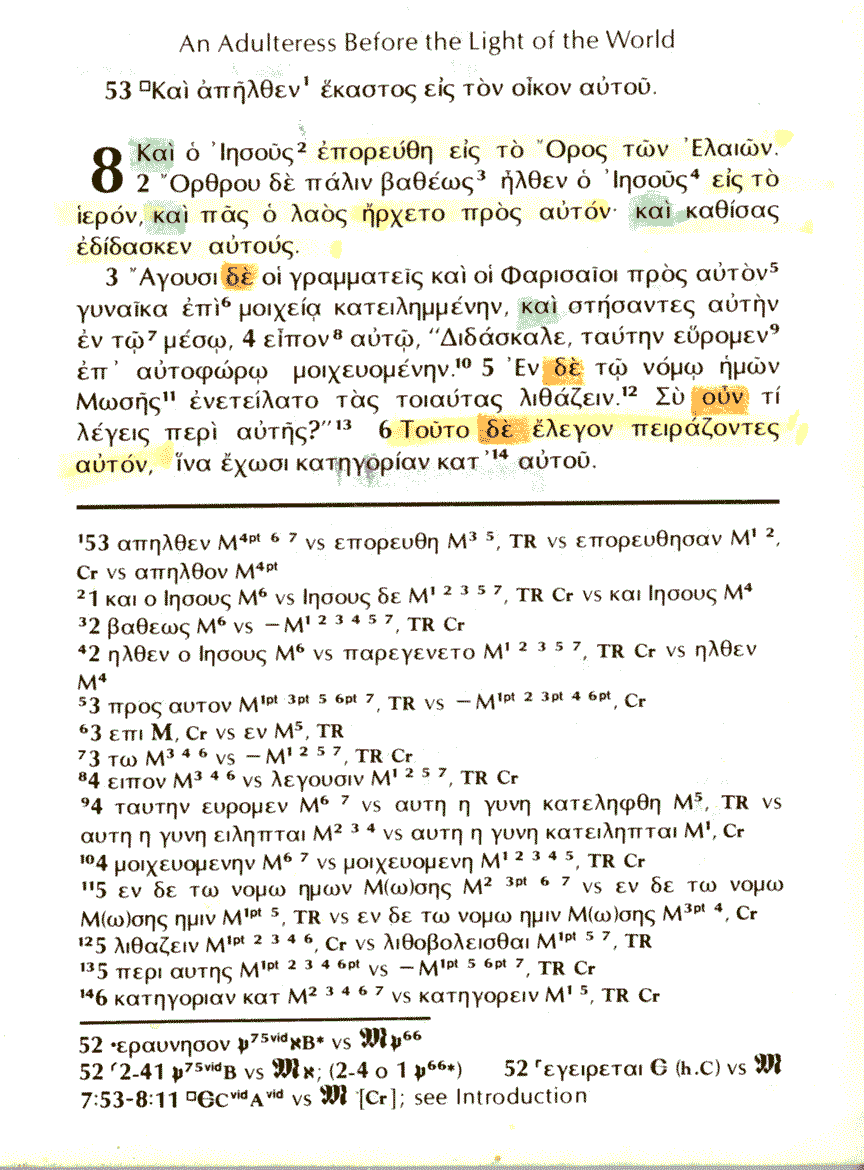
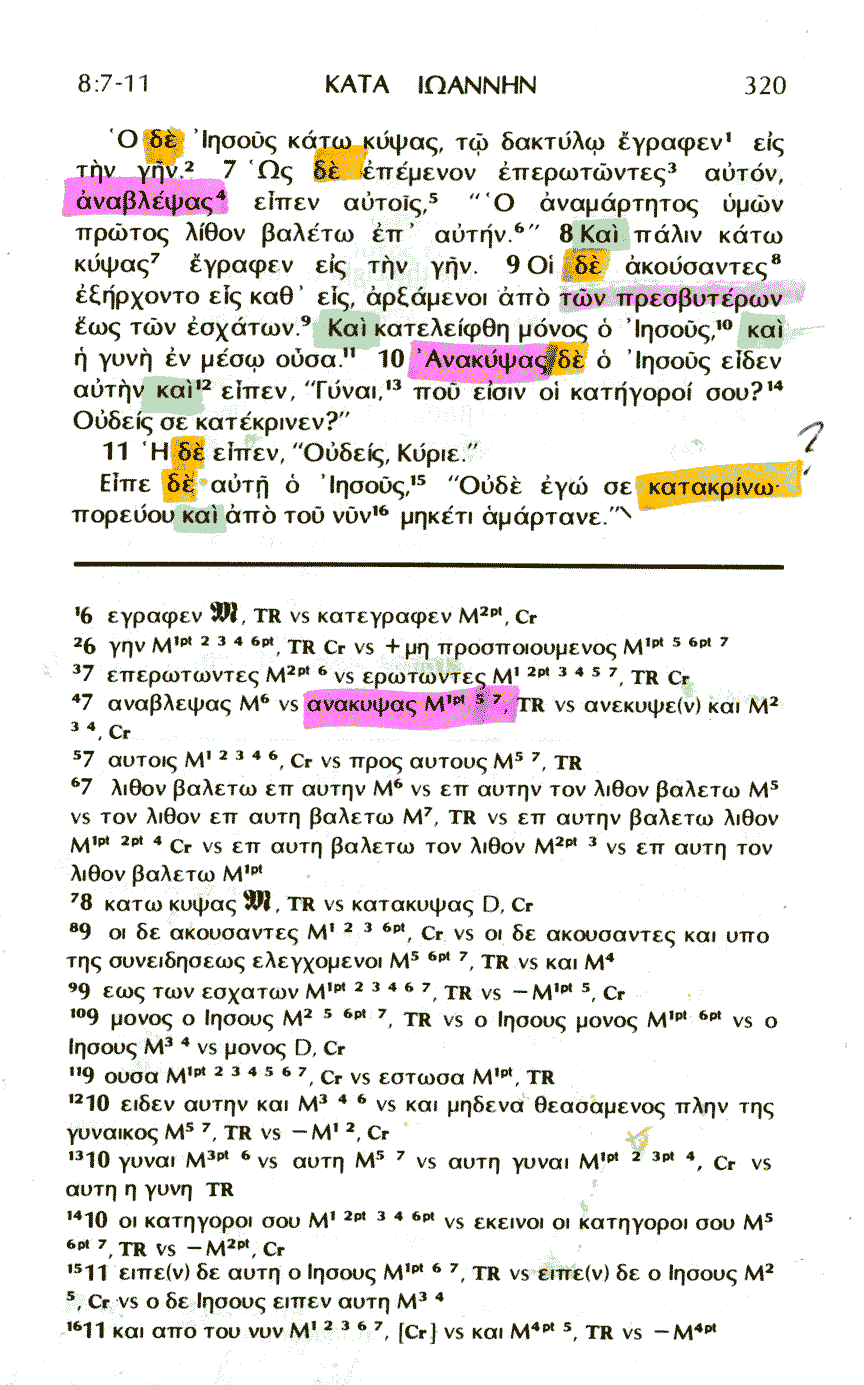
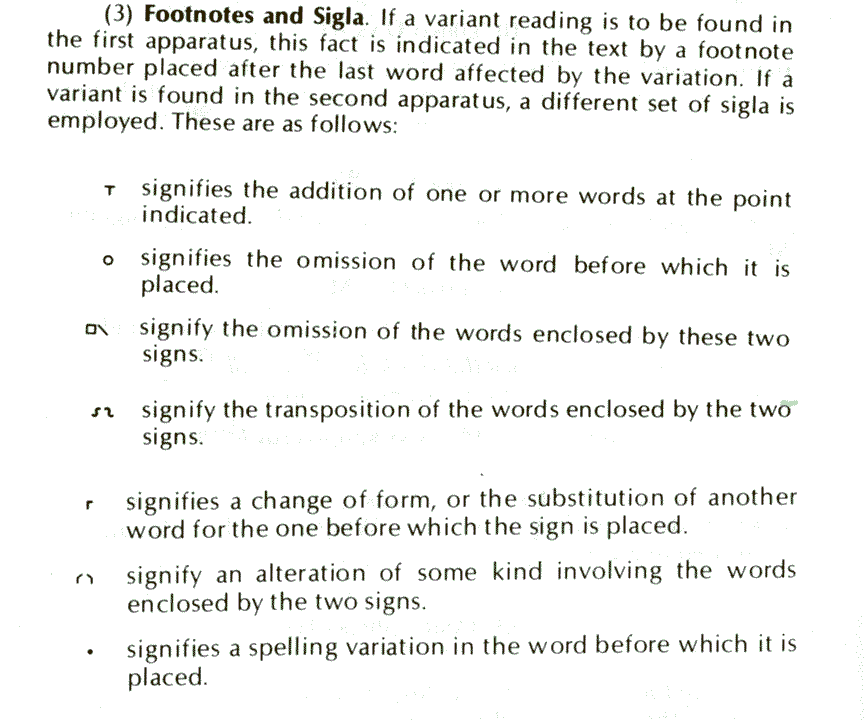
Footnotes:
